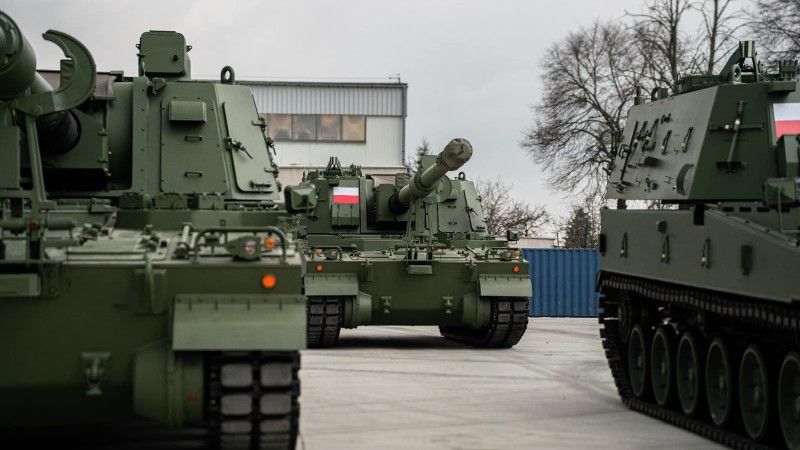South Korean defence firms urged to invest more in Poland [OPINION]

South Korean companies have become one of the main suppliers of armaments to Poland and European countries following the Russian aggression in Ukraine. However, European countries are placing increasing emphasis on developing their own capabilities. Furthermore, the new requirements of the European Union to finance armaments with common funds make the localisation of production and cooperation with industry inside the EU even more important in order to continue extensive operations. So if South Korean companies want to maintain and expand its position in the European market, they should invest in production capacity on the Old Continent.
Hanwha Aerospace, a key defence contractor from South Korea, has been present in the European defence market for more than a decade, as exemplified by the licence for the K9 howitzer chassis for the still-successfully-developing Polish Krab programme, or contracts to sell howitzers to Norway, Finland and Estonia. However, it was only after the Russian full-scale aggression against Ukraine in 2022 that it became a major player in Europe, including Poland. Between 2022 and 2024, Hanwha Aerospace entered into executive contracts for the delivery of a total of 364 K9A1 and K9PL howitzers and 290 Homar-K multi-launcher rocket systems, based on the Korean Chunmoo system. Hanwha also signed a contract in May 2024 to supply more than 50 K9 self-propelled howitzers to Romania, most of which will be built at a newly constructed domestic plant. Countries that already had K9 howitzers in their inventories before the full-scale war in Ukraine have also decided to purchase additional K9 howitzers. These include Estonia (an additional 12 were ordered in 2023), Finland (38 were purchased as an option at the end of 2022) and Norway, which still exercised an option under a previously signed K9 contract in 2022 by acquiring howitzers additional guns and eight ammunition vehicles, and is now planning to purchase another battalions with 24 howitzers.
In practice, this means that Hanwha Aerospace has become the largest supplier of artillery to European NATO countries and EU members (and Norway, which closely cooperates with the EU) in recent years. Today, however, the Korean company’s position is in some ways under threat, as the conditions surrounding the financing of defence investments are changing. Until recently, they were funded almost exclusively at the national level, which gave individual countries a great deal of freedom in terms of where purchases are made and how they are financed. The ability to respond quickly to demand and the significant volume of deliveries at short notice that Hanwha provided was crucial for many countries, including Poland, which became the largest user of K9 howitzers.
Read more
However, the conditions of arms purchases in EU member states are changing. The increase in defence spending and associated costs is causing member states to seek opportunities for more favourable financing, including with shared resources. At the beginning of 2025, the European Union announced a number of defence-related initiatives as part of the so-called White Paper and the ReArm Europe programme. It is envisaged that, in addition to the loosening of rules related to the budget deficit (by default, it should not exceed 3 per cent of GDP per year, but now this threshold can be periodically increased by 1.5 per cent of GDP due to additional defence spending), the SAFE (Security Action for Europe) joint lending facility will be created. It is envisaged to prepare a pool of 150 billion euros of favourably-interest-bearing loans from which interested countries can finance priority arms purchases.
According to available estimates, Poland can count on around EUR 20 billion, i.e. around USD 22 billion or PLN 85 billion, from the SAFE instrument. However, the use of this instrument comes with certain restrictions. According to the draft regulation establishing SAFE, at least 65 per cent of the components must come from an EU country, Norway or Ukraine. This means that contractors from outside the European Union may find it much more difficult to bid for further contracts if they fail to ensure that this criterion is met. There are already reports that Poland will want to use the SAFE instrument for the Orka submarine programme, which puts European contractors - from Germany, France, Italy or Sweden - in an advantageous position vis-à-vis the Korean industry.
Read more
Hanwha Aerospace, however, has further opportunities in Poland, should the South Korean defence giant be ready to make more active investments in Poland. At present, the priority is to build capacity for the production of CGR-080 missiles, designed for the Homar-K launcher, in Poland. To this end, a Polish-Korean joint venture is to be established, with 51 per cent of Hanwha Aerospace and 49 per cent of Poland’s WB Electronics. A term sheet on the terms of the joint venture was signed in April and, once established, the company is to handle the production of these missiles first and then also the joint development of longer-range missiles.
Noteworthy, there is talk of using the missiles produced by the company also in other markets and missile systems. - „The investment that WB Group and Hanwha Aerospace plan to make under Executive Agreement No. 3 will be a major developmental boost for Polish industry. For us, for the Ministry of Defence, ensuring the production in Poland of modern ammunition for the Homar-K system, which we have acquired in such significant numbers, is one of the most important priorities,” Deputy Defence Minister Paweł Bejda was quoted as saying in an interview with Defence24.pl. The Homar-K programme is, by the way, an example of very good cooperation with Polish industry, as the first executive contract with the Korean launcher already integrated the Polish Jelcz vehicle and fire control system, while the second contract transferred the technology for the production of launchers and pods for 122 mm rockets.

Photo. st. szer. Anna Trypuć / 1. Mazurska Brygada Artylerii
Representatives of the Polish Ministry of Defence are still interested in acquiring equipment from the Republic of Korea, and the creation of joint ventures is pointed to as an example of how entities from countries outside the European Union - such as the USA or precisely the Republic of Korea - can participate in European defence programmes and strengthen the Polish defence industry. This has been repeatedly mentioned by both the Deputy Prime Minister, Minister of National Defence Władysław Kosiniak-Kamysz, and the Deputy Minister in charge of modernisation, Paweł Bejda.
It is clear that Hanwha Aerospace, and other Korean contractors, in order to continue winning equipment orders from the Ministry of Defence, must be more involved in cooperation with Polish industry and make more investments in the Polish market. This is due not only to the policy of the European Union, but also to the goals set by individual countries in terms of industrial independence, logistical support and economic development.
This is particularly true in case of Poland, which, as Lt. gen (R.) Waldemar Skrzypczak, former Polish Land Forces commander, points out in conversation with Defence24.pl, has already made substantial purchases in Republic of Korea and expects capital investments to boost the industry in Poland. „I strongly believe that Korean companies should invest capital in the Polish arms industry. With the scale of orders they have received before, this is an obvious and necessary solution. Korean investments are necessary to talk about further purchases from Korea. It cannot be that Poland only buys equipment for billions, often through loans. I emphasise that it should also be Korean capital, invested either in building Korean facilities in Poland or joint Polish-Korean facilities” - Lt. gen (R.) Waldemar Skrzypczak.
The need for Korean investments was explicitly stated by Deputy Defence Minister Paweł Bejda in an interview with Defence24.pl, in the context of the K9PL howitzers: „We plan to further develop this cooperation up to the point of undertaking production of howitzers in the K9PL variant in Poland, which will be an important strengthening of Polish industry. We expect our partners to invest in the industrial base in Poland. One of the most important objectives of the Ministry of Defence is the development of the Polish defence industry.”
One joint venture, on Homar-K, is a step in the right direction, but looking at the whole picture, it is still not enough. Many more similar investments are needed to effectively develop Polish-Korean cooperation. Investments on the Polish market, with the involvement of Korean capital, should be made, and on a large scale, larger than at present
as general Skrzypczak pointed out.
As General Skrzypczak said, the Homar-K programme, which involves cooperation with Poland up to the creation of a joint venture, is a step in the right direction. However, investments on a much larger scale are needed. Thus, in order for Hanwha to be able to invest in Poland and other European countries, it is necessary to raise adequate capital, which will then need to be invested in the industry in Poland and European countries.
He added that now countries like Germany and France do not have the capacity to meet all the demand for defence products now. So now, there is a window of opportunity for European procurement of the systems produced in cooperation with partners from outside EU, such as Korea, potentially also with EU funding. After the capacity in France and Germany is established, starting new projects will become more difficult, also due to future regulatory changes on EU level influenced by those countries. Thus, investments of Korean companies should be implemented promptly, ideally within 1,5 to 2 years.

Photo. Hanwha Ocean
As for the Orka program, Hanwha still has chances to win the contract for four submarines should the South Korean defence group offer a comprehensive package of proposals, including active investment plans. In April, Hanwha Ocean presented a new offer to address Poland’s naval operational requirements, transitional training needs, and an investment for the Polish shipbuilding industry. The shipyard is proposing an accelerated delivery of three KSS-III Batch 2 submarines, with the lead ship arriving within six years of the contract signing. During the transitional period, the Koreans pledged to lease an additional submarine, on which Polish crews would undergo training and maintain their operational skills. Moreover, Hanwha Ocean offered to establish an independent MRO (Maintenance, Repair & Overhaul) Support Center in Poland, pledging to invest 100 million USD into the Polish shipbuilding sector. As part of this commitment, the Korean company aims to modernize infrastructure, train personnel, support R&D activities, and cooperate with Polish shipyards in the construction and servicing of civilian vessels.
Hanwha Aerospace’s management is aware both of the need to invest more in its manufacturing location and local industry to maintain and expand its position in Europe, and of the need for additional financing. Hanwha Aerospace’s board of directors in April proposed a share issue of 2.3 trillion won, or about US$1.6 billion. In this way, capital is to be raised to enable key investments, including in the location of production. In the case of Poland, this could involve investments related to the production of more than three hundred K9PL howitzers, a condition of the Polish Ministry of Defence for production, but also broader involvement in entities that could be part of the supply chain of Hanwha and others in defence programmes.
To grow in the Polish and European market, which is increasingly taking into account the requirements for industrial cooperation and external partners« investment in local industry, a trend recently supported by EU regulations, Hanwha Aerospace needs to secure additional capital to then invest in Europe. In this way, the company is expected to become not only a supplier to Europe, but also a manufacturer and a broad partner of European companies.





